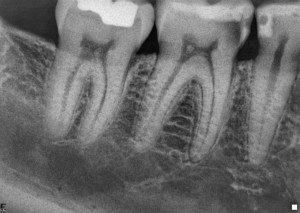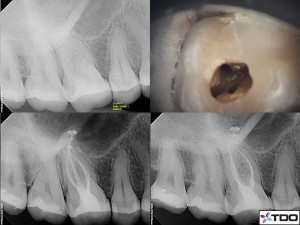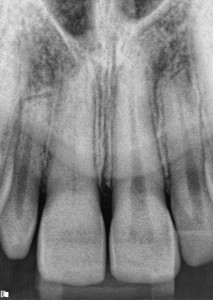Let’s discuss the who, what, when, where and why of calcification.
Who: Any tooth that has vital pulp tissue that is placed under duress.
What and When: The narrowing of the pulp chamber and/or canals created by deposition of dentin. This is a naturally occurring phenomenon(secondary dentin), although the process can be accelerated by external stimuli(tertiary dentin).
Where: The process begins in the coronal pulp, and proceeds apically.
Why: As a result of noxious stimuli, the pulp will attempt to insulate itself by laying down hard tissue.
I see calcification every day. I see it on diagnostic films, and clinically as well.
From an isolated pulp stone seen on a radiograph during diagnosis:
To an isolated pulp stone seen clinically:
The first question is, how do you deal with calcified cases? The easiest way to deal with them, is to use a Dental operating microscope. With the assistance of the microscope, it is rare that a tooth cannot be treated. It takes practice, experience and concentration and most importantly, time.
What would you do with this case?
This young man suffered a traumatic blow to tooth #8 three years ago. Upon review of the radiograph at his general dentist, he was referred for an evaluation and is asymptomatic at this time.
Tooth #7, 8 and 9 all tested vital. Positive to cold, negative to percussion and palpation.
Should tooth #8 be treated? What about the calcification?
I elected not to treat this tooth. It repeatedly tested vital, there were no signs of periapical or periradicular breakdown, and a great deal of time has passed since the traumatic incident occurred. In addition, although there is some slight discoloration, the patient is not interested in treatment for the discoloration at this time.
Some people would argue that the signficant calcification would make this tooth difficult to treat. I would agree that it would be more challenging than the adjacent central. However, treatment would be challenging whether it was done today or further down the line.
Sometimes, less (treatment) is more.



My observation: on more than one occasion, I have started endo therapy on anterior teeth with history of trauma and radiographically visible canals, only to find total calcification; not even a “stick” with a file at any point in the canal. It is interesting that radiographs really deal with differing densities and don’t always reveal the true situation.
I’m with you Doc. When you consider that the tooth is just trying to insulate itself, it’s no surprise that sometimes that protective mechanism is successful in completely occluding the canal system.